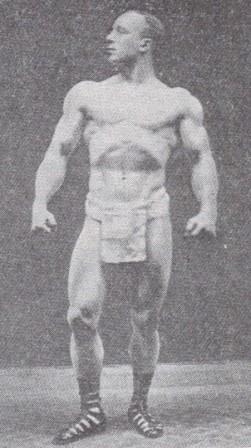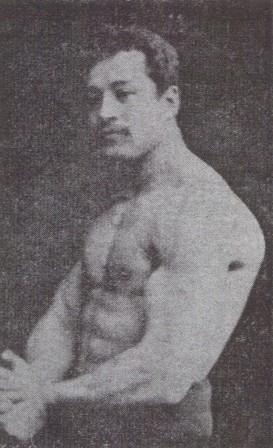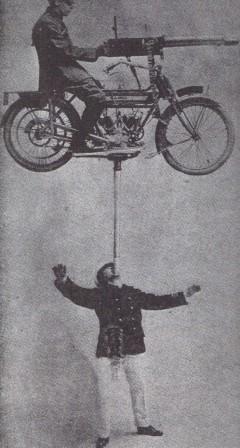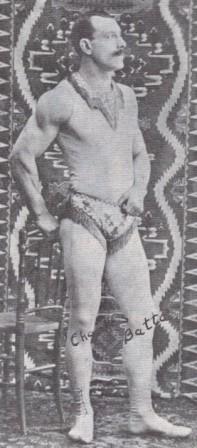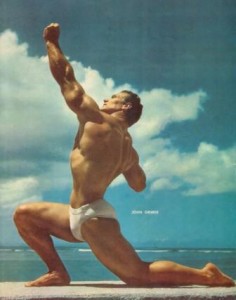Alfred Monte Woolaston – AKA Monte Saldo
by Dennis Mitchell
Alfred Monte Woolaston was born in 1879 in Highgate, London England. His father, Fredrick Woolaston was a shoe manufacturer, a Methodist preacher, and a faith healer. Alfred developed an interest in strength at an early age and in his early teens was a member of the London weightlifting club, where he came in contact with many notable lifters. His family encouraged him, especially his uncle a police inspector, who being very prominent socially, managed to arrange for him to become an apprentice to Eugene Sandow at Sandow’s gym. Alfred was a hard worker and not only improved his strength, but learned much about performing, while helping Sandow in his stage performances.
In 1900 Alfred teamed up with Ronco, an Italian strongman, and they became “Ronco and Monte” ( Alfred was now known as Monte Saldo ) and opened at the Cafe Chantant, Crystal Palace, where they were very successful. After their engagement at the Crystal Palace they went on a tour of Europe where their act so impressed an English theatrical agent they got a six month contract to appear at the Royal Aquarium in Westminster, London. This was during the “Golden Years of Strongmen”. It was common for strongmen performers to offer large amounts of money to their spectators if they could duplicate any of their feats of strength. While they never had to pay anyone, their challenges did result in setting up a contest between Monte and a lifter named Charles Russell. Russell was the British amateur 140 pound champion. Russell could not duplicate any of Monte’s stage lifts, however he did challenge Monte to the five lifts used in amateur competition. Monte accepted the challenge, even though he did not train on these lifts and Russell was the winner. Monte learned his lesson and never went into another contest until he trained on the contest lifts. Ronco and Monte’s act was so successful their performance was extended beyond the six months. At the end of their engagement at the Royal Aquarium, Ronco and Monte ended their partnership. Ronco went back to Italy and Monte and his brother Frank formed their own act and performed in Dresden, Amsterdam, Hamburg, Saxony, Prague and in Parism where they were regulars at Professor Desbonnet’s gym. During a performance in Hamburg they were offered a full season contract by Frank Glennister to perform at the London Pavilion. It was at the Pavilion that Monte would support a car, with passengers, in the support known as “The Tomb of Hercules”. An amazing feat for a man weighing only 144 pounds. For a time Monte did a solo act, but in 1906 he and his brother Frank joined up again to perform a new act called “The Sculptor’s Dream” . The act began with the sculptor admiring his latest work, a statue of a muscular athlete. The statue was placed before a mirror so that the audience could see both it’s front and back. The sculptor, tired from his work fell asleep on the studio couch. At this point the statue came to life and went through a series of poses in front of the mirror so the audience could view both the front and back of the statue. Suddenly the statue reached through the mirror and pulled out his reflection (his brother Frank) and they did acrobatics, hand to hand balancing, lifting each other and wrestling, all synchronized to music. As the sculptor woke up the statue and his reflection returned to their original position as the act ended.
Next in the career of Monty, he teamed up with William Bankier (Apollo) and opened the Apollo Academy in London. Their Academy attracted many of the famous lifters and wrestlers of that time. It was at the Academy that Arthur Saxon did a bent press with 386 pounds. It was weighed and witnessed by the editor of Health and Strength magazine, Bill Klein, also John Murry and William Bankier (Apollo). Monte was hailed as one of the best trainers, and next teamed up with Max Sick, who was professionally known as Maxick. Together they marketed the Maxaldo Method of Muscle Control which was a method of training using no equipment, to improve muscle development, speed and stamina. The name was later changed to Maxalding, and the course was sold into the 1970’s.
Monte was active in organizing the British Amateur Weightlifting Association, (BAWLA) and served on the committee for professional lifters. Monte weighed 144 pounds, stood 5’5″, had a 17″ neck, 45.5″ chest, 16″ arms, 13″ forearms, 30″ waste, 23″ thighs and 15,5″ calves. He could bent press 230 pounds and was the first man in England to do a one arm swing with more than body weight, doing 150 pounds. He is credited with showing that the swing was best done with a dumbbell loaded unevenly, with more weight on the back end of the bell.
Monte was a very well educated man. He was a very good musician, and was fluent in several languages. World war II was very devastating for Monte’s family. His wife was killed during a bombing raid on London. Monty and his daughter, Theresa, were seriously injured, and his son was killed during the invasion of Europe. Monty never fully recovered from his injuries and the loss of his wife and son. He passed away at the age of seventy in 1949.
